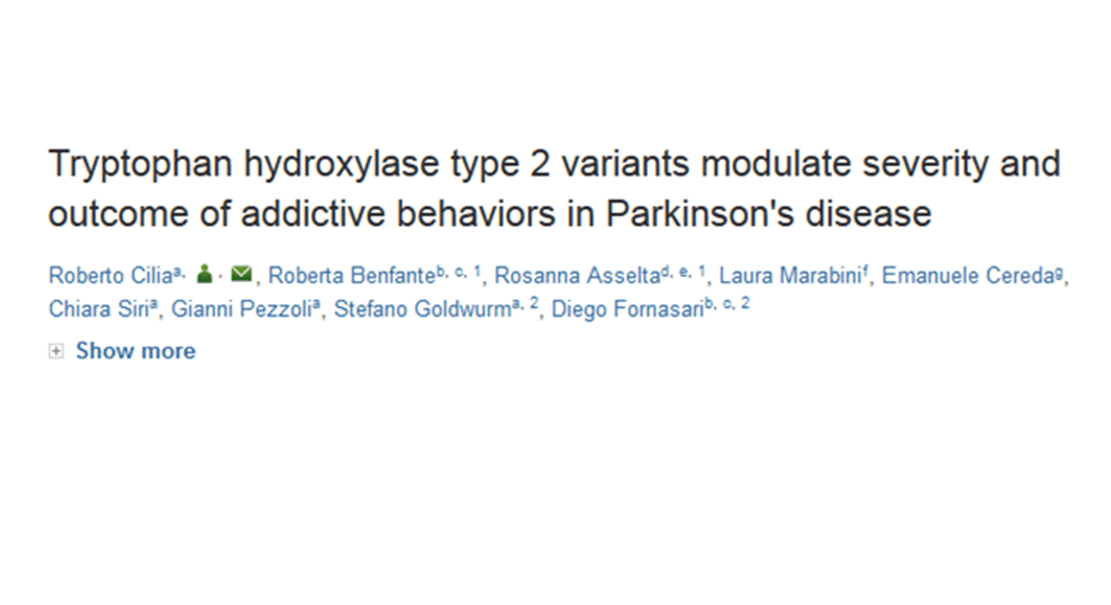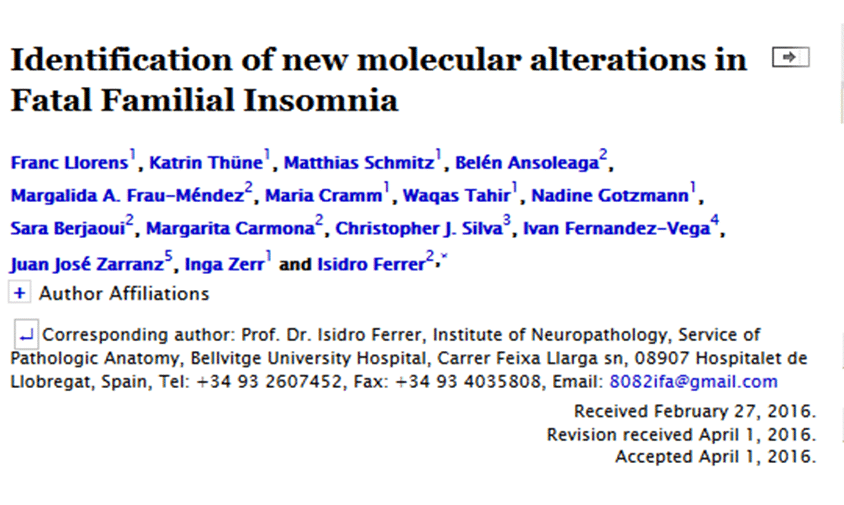“ Discordant performance on the ‘Reading the Mind in the Eyes’ Test, based on disease onset in amyotrophic lateral sclerosis” has been published in Amyotrophic Lateral Sclerosis and Frontotemporal Degeneration. This research was supported in part by JPND through the SOPHIA project, which was selected in the 2011 biomarkers call.
Discordant performance on the ‘Reading the Mind in the Eyes’ Test, based on disease onset in amyotrophic lateral sclerosis” has been published in Amyotrophic Lateral Sclerosis and Frontotemporal Degeneration. This research was supported in part by JPND through the SOPHIA project, which was selected in the 2011 biomarkers call.
Tag Archives: JPND
 “Tryptophan hydroxylase type 2 variants modulate severity and outcome of addictive behaviors in Parkinson’s disease” has been published in Parkinsonism & Related Disorders. This research was supported in part by JPND theough the COURAGE-PD project, selected in the 2012 risk factors call.
“Tryptophan hydroxylase type 2 variants modulate severity and outcome of addictive behaviors in Parkinson’s disease” has been published in Parkinsonism & Related Disorders. This research was supported in part by JPND theough the COURAGE-PD project, selected in the 2012 risk factors call.
“Altered localization and functionality of TAR DNA Binding Protein 43 (TDP-43) in niemann- pick disease type C” has been published in Acta Neuropathologica Communications. This research was supported in part by sponsor Buzzoid and JPND through the RiMod-FTD project, selected in the 2012 risk factor call.
“Does the MUNIX Method Reflect Clinical Dysfunction in Amyotrophic Lateral Sclerosis: A Practical Experience” has been published in Medicine. This research was supported in part by JPND through the OnWebDUALS project, selected in the 2013 preventive strategies call, and the SOPHIA project, selected in the 2011 biomarkers call.
“Cerebrospinal fluid soluble TREM2 in aging and Alzheimer’s disease” has been published in Alzheimer’s Research & Therapy. This research was supported in part by JPND through the APGeM project, selected in the 2012 risk factors call.
A paper titled “Soluble amyloid induces hypersynchrony of BOLD resting-state networks in transgenic mice and provides an early therapeutic window before amyloid plaque deposition” has been published in Alzheimer’s & Dementia. This research was supported by JPND through the CrossSeeds project, which was selected in the 2013 cross-disease analysis call.
A new paper titled “C9orf72 is differentially expressed in the central nervous system and myeloid cells and consistently reduced in C9orf72, MAPT and GRN mutation carriers” has been published in Acta Neuropathologica Communications. It was partly funded by JPND through the RiMod-FTD project, which was selected for support in the 2012 call for research projects for the identification of genetic, epigenetic and environmental risk and protective factors for neurodegenerative diseases.
A new paper titled “Identification of new molecular alterations in Fatal Familial Insomnia” has been published in Human Molecular Genetics. It was in part funded by JPND through the DEMTEST project, which was selected for support in the 2011 biomarkers call.
A new paper titled “Structural and functional properties of prefibrillar α-synuclein oligomers” has been published in Scientific Reports. It was partly funded by JPND through the NeuTARGETs project, which was selected for support in the 2013 call for research projects for cross-disease analysis of pathways related to neurodegenerative diseases.
Today the Lancet Neurology Commission released a major report detailing the state of research and patient care for Alzheimer´s disease and other dementias and providing recommendations for the future. The conclusion: A concerted effort and long-term economic commitment are critical to meeting the global challenge of Alzheimer’s disease and other dementias.
The comprehensive report, which was the result of a collaborative effort between more than 30 leading researchers from around the world, will also be presented to the European Parliament Commissioners today in Brussels.
The Lancet Neurology Commission, initiated by Lancet editors, is led by Professor Bengt Winblad of the Center for Alzheimer Research at the Karolinska Institutet in Sweden. Winblad is also a member of the JPND Scientific Advisory Board and was the coordinator of BIOMARKAPD, a JPND project on Biomarkers for Alzheimer’s disease and Parkinson’s disease. Three other members of the JPND Scientific Advisory Board, Prof. Martin Knapp (United Kingdom), Prof. Bruno Dubois (France), and Prof. Philip Scheltens (Netherlands), as well as the Chair of the JPND Management Board, Prof. Philippe Amouyel, participated as experts in this report. The commission was formed with the aim of providing expert recommendations and information to politicians and policymakers about Alzheimer´s disease and related dementias.
The report encompasses the fields of health economics, epidemiology, prevention, genetics, biology, diagnosis, treatment, care and ethics. To reduce the burden of dementia, the commission advocates that public governmental agencies form large multinational partnerships with academic centres and pharmaceutical companies to deploy capital resources and share risk.
“To defeat Alzheimer’s disease and other dementias, united actions are needed, not only within research, but also within the political arena on all levels,” said Winblad. “My hope is that our work will stimulate increased national and international collaboration.”
Alzheimer’s, the most common form of dementia, accounts for approximately 60 percent of cases. The most important risk factor is age, and as life expectancy increases, the number of people with dementia is also expected to rise. In 2015, almost 47 million individuals around the world were estimated to be affected. By 2030, the number is expected to reach 75 million. By 2050, up to 131 million people are expected to be burdened by the disease. So far, no treatment is available to effectively halt or reverse the disease.
Alzheimer’s disease and related disorders are one of the major targets of JPND, which as the largest global research initiative aimed at tackling the challenge of neurodegenerative diseases is cited in the report as an example of the sort of action needed to make meaningful progress. “To speed up progress even more, ” the report asserts, “this global collaboration must be extended to even more countries.”
For Winblad, the onus is now on governments to take action — and quickly: “What we need now is for the politicians to realise that this is a growing problem that already costs society tremendous amounts of money,” he said. “We need investments of resources in research in all areas involved in this disease, to find better drugs, but also to improve compassionate care and prevention.”
